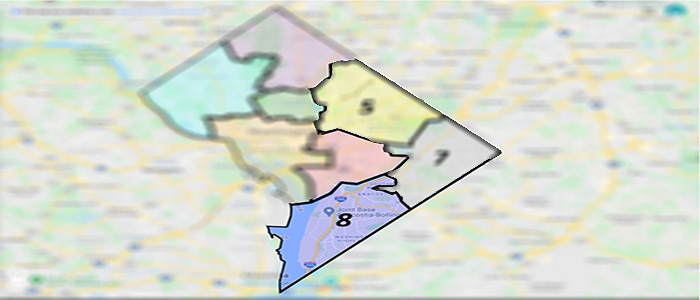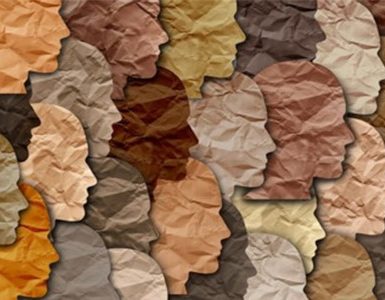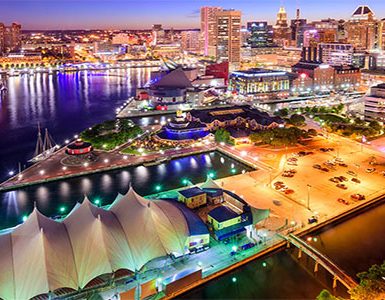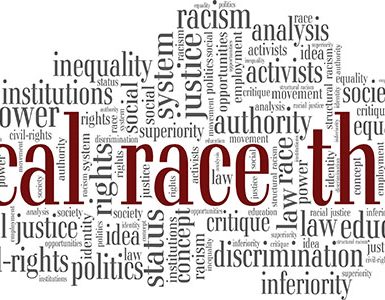Eight wards make up the District of Columbia (D.C.). Of these, wards 5, 7, and 8 are considered the most underserved. Compared to their wealthier neighbors from Wards 2 and 3, residents of Ward 5, 7, and 8 tend to have lower median household incomes and struggle with greater barriers to access to public and social services.
We complete our deep dive into D.C.’s most underserved communities by visiting Ward 8, located in the far southeast and southwest corner of D.C. We examine this ward and its residents by taking both a historical and modern-day perspective, discuss predominant racial and socioeconomic disparities, and raise awareness about the current advocacy work being done to address ongoing social concerns related to healthcare, education, affordable housing, and additional measures.
Washington D.C.’s Ward 8 Demographics: Historic and Current Perspectives
Beginning mostly as farmland back in D.C.’s early history, Ward 8 is home to the historic Anacostia neighborhood, which was originally founded as Uniontown, one of D.C.’s first suburbs in 1854. One of the area’s most famous former residents was abolitionist and anti-slavery activist, public speaker, and author Frederick Douglass (1817 – 1895), later known as the “Sage of Anacostia.”
According to the Ward Eight Heritage Guide, this ward has more vacant land than any other area of the city. Residential development was limited in Ward 8 until the 1940s, and in the 1950s legal rulings heralded the ward’s demographic shift from a white to a predominantly black neighborhood. Government-funded and subsidized housing is prevalent in Ward 8, which has earned the dubious reputation as home to some of the district’s poorest racial and ethnic minorities—a reputation which “ignores the ward’s surviving historic character,” offers the Guide.
According to the latest demographic data from DC Health Matters, Ward 8 has a population of 80,517 people (out of 717,717 total D.C. residents). Over 91% of Ward 8 residents (73,946 people) are Black/African-American. Slightly more than 4% of Ward 8 residents are White/Caucasian, with remaining residents identifying as Native Hawaiian/Pacific Islanders, Asians, American Indians/Alaskan Natives, or another race. More impoverished children live in Ward 8 than in any other ward in the District, with over 4,000 families with children living below the poverty line (and more than 5,000 families below the poverty line in total).
The median household income in Ward 8 is $39,473, the lowest in the District. Like Wards 5 and 7, the median household income for Black/African-Americans in Ward 8 ($37,335) is significantly lower than that of white residents ($108,199). Fewer than 40 percent of Ward 8 residents older than 25 are high school graduates. At the moment, a devastating 18.04% of Ward 8 residents face unemployment, well over double the unemployment rate of the District as a whole.
Beyond unemployment, Ward 8 is also home to several other societal challenges, as well. This area has only one full-service grocery store, as well as half of all the District’s food deserts (the D.C. Policy Center defines food deserts as a geographical area where the walking distance to a grocery store is over 0.5 miles, more than 40 percent of households have no vehicle, and the median household income is less than 185 percent of the federal poverty line for a family of four). While recent data indicates overall crime rates are dropping, homicide and gun violence remain a significant concern. Ward 8 neighborhoods, including Congress Heights, Bellevue, and Washington Highlands are home to the greatest number of at-risk students and students with disabilities, according to the D.C. Policy Center. And due to a nuanced combination of factors like poverty and a lack of access to medical care and healthy food, residents of Ward 8 have been among the hardest hit by COVID-19.
What’s Being Done? Advocacy Action in Ward 8
It’s clear that racial and socioeconomic inequities continue to plague this historic area of Washington D.C. However, numerous, multidisciplinary efforts are being made to combat these problems and empower Ward 8 residents.
As an example, the Washington D.C. area has the fastest-improving learning outcomes in the nation. The D.C. Policy Center notes that enrollment, educational program offerings, and academic achievements in the city have made tremendous strides. Promise extends to Ward 8, as well, although its children continue to struggle with decreased access to high-quality education. (With 41, Ward 8 has more public schools than any other ward—but also the least amount of highly rated schools.)
Steps to address barriers to medical care are being taken, too. In April 2020, Mayor Muriel Bowser announced that a new hospital will be built in Ward 8 in collaboration with the District government and George Washington University; it is expected to open in 2024.
One ongoing challenge for Ward 8 residents s balancing the desire to promote affordable housing and retail development while at the same time preserving historic buildings, areas, and views. The Anacostia Coordinating Council (ACC) is championing an initiative known as Ward 8 Woods, which intends to “increase home-grown stewardship, jobs, and pride” in the Ward’s parks. Objectives include cleaning up waterways, reducing harmful run-off, promoting anti-litter campaigns, hauling away trash, and promoting urban green space techniques, in addition to offering a select number of jobs for Ward 8 residents.
These advocacy efforts are not all-inclusive, and there is still a lot of hard work left to do by policymakers, elected officials, community advocates, and community members alike.
Conclusion
Like Wards 5 and 7, Ward 8 is home to some of the poorest families in Washington D.C. Community stakeholders including the Anacostia Coordinating Council and Frederick Douglass National Historic Site, are actively working to support and empower Ward 8 residents. To become an ally to those in Ward 8, readers are also encouraged to reach out to local and national advocacy groups.


















Add comment